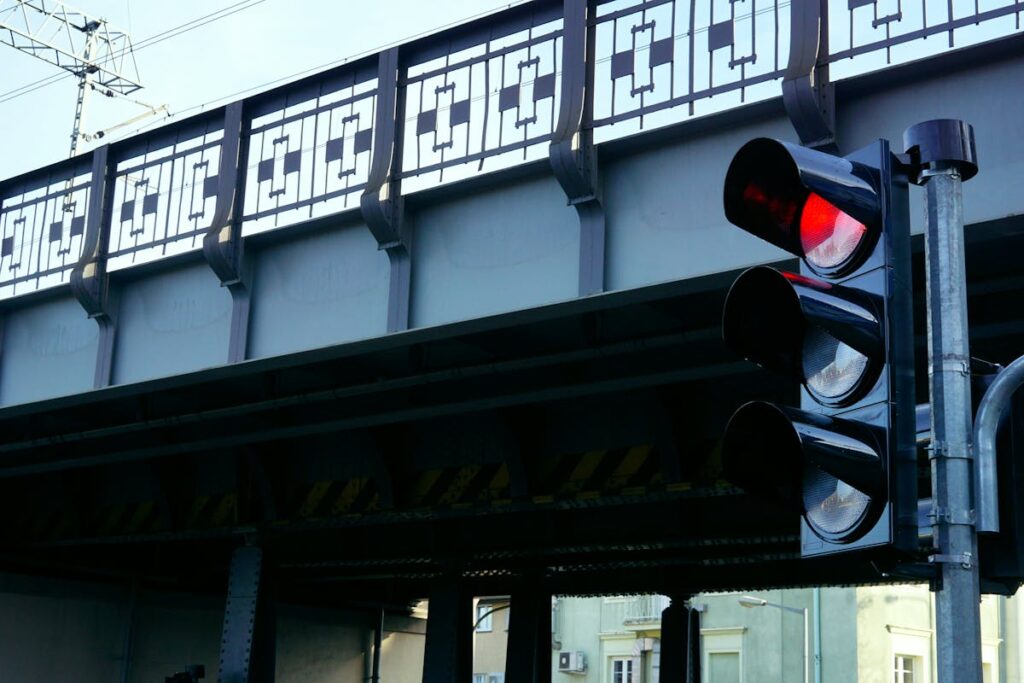In the late 19th century, the first traffic lights emerged as manually operated signals, effectively guiding horse-drawn carriages and pedestrians through busy intersections. The inaugural gas-lit traffic light, installed in London in 1868, faced numerous challenges but nonetheless, was instrumental in paving the way for electric signals in the early 20th century. The advent of these traffic management instruments played a crucial role in mitigating road accidents. However, the question lingers, to what extent did these initial inventions influence the landscape of contemporary traffic control and accident prevention?
The Early Beginnings of Traffic Lights
The world’s first traffic light, a pioneering invention, made its debut in the late 19th century. Its historical significance cannot be overstated, as it revolutionized the way traffic was managed and guided on the roads, thereby playing an essential role in accident prevention.
The early traffic lights were manually operated, requiring a police officer to switch the signals to control the flow of traffic. This marked a significant step in technological advancements, reducing reliance on human discretion and introducing a more systematic approach. The device consisted of two arms that were elevated to signal ‘stop’ and ‘go’, and was particularly beneficial in controlling horse-drawn vehicles and pedestrians.
The adoption of traffic lights marked a turning point in urban planning and infrastructure, laying the foundation for the modern systems that we recognize today. The initial invention has undergone numerous transformations, adapting to the changing dynamics of transportation over the years. While the basic concept remains unchanged, the evolution of traffic lights has been driven by technological advancements, shaping the roads as we understand them today. The importance of these early traffic lights is deeply rooted in their contribution towards enhanced road safety and efficient traffic management.
The First Gas-lit Traffic Light
Innovative in its design, the first gas-lit traffic light emerged as a critical solution for managing urban traffic during the dusk and dawn hours. This inventive apparatus, harnessing the power of gas lamp technology, was installed outside the Houses of Parliament in London in 1868, marking a significant stride in early signaling.
The gas-lit traffic light was the brainchild of railway signaling engineer J.P. Knight, who saw the pressing need for a more effective traffic control mechanism in the bustling streets of London. The system was not unlike railway signals, equipped with a revolving lantern with red and green signals. The red light signaled ‘stop’, and the green light signaled ‘caution’.
However, it wasn’t without its challenges. Gas lamp technology at the time was still in its infancy, and the volatile nature of gas led to several instances of explosions. Despite this, the gas-lit traffic light laid the groundwork for future innovations in traffic control, demonstrating that structured, regulated signaling could effectively manage traffic and, importantly, reduce accidents. This early signaling system served as a pivotal stepping stone in the evolution of traffic regulation, paving the way for subsequent developments.
Evolution Into Electric Traffic Lights
Moving from the era of gas-lit signals, the advent of electric traffic lights marked a significant turning point in traffic management and accident prevention. The birth of electric signals brought about a more reliable and visible means of controlling traffic, consequently enhancing road safety. This shift had immense implications for urban planning, traffic law enforcement and, most importantly, the reduction of road accidents.
Birth of Electric Signals
Emerging from a necessity for safer roadways, the evolution into electric traffic lights marked a significant milestone in the history of traffic control. The birth signals of this electric innovation began with the work of Lester Wire, a police officer from Salt Lake City, in 1912. Wire developed a simple wooden box with colored light bulbs which could be manually controlled to manage street intersections.
Before his invention, traffic was controlled by police officers manually directing vehicles and pedestrians, which was inefficient and unsafe. Wire’s invention was the first step towards automated control, allowing for a safer and more efficient flow of traffic.
The next development came with the introduction of automatic control in 1922. This was facilitated by Garrett Morgan, an African-American inventor, who patented an automatic traffic signal system. His system incorporated an intermediary “all stop” stage, which greatly reduced the risk of collisions by ensuring all traffic was stopped before directions were changed.
The evolution of traffic lights into electric devices was not just about technological advancement; it was essential for improving safety on our roads. This evolution shows how innovation can transform a simple concept into a life-saving mechanism, a reflection of human ingenuity and the constant pursuit of betterment.
Traffic Lights and Safety
The evolution of traffic lights into electric signals was a significant advancement, but the story does not end there. This monumental shift in traffic signal design further paved the way for enhanced pedestrian safety and more efficient control of vehicular traffic. The integration of electricity into traffic signals allowed for a more reliable, visible, and consistent way to manage traffic, thereby reducing the risk of accidents.
The new traffic signal design incorporated standard colors (red, yellow, green), each representing a specific command. This not only introduced a universal language for motorists but also provided pedestrians with a safe way to cross roads. The electric signals could be programmed to adjust according to the time of day and traffic conditions, further improving their efficacy in accident prevention.
Moreover, the advent of pedestrian countdown timers and crosswalk signals in the 20th century dramatically increased pedestrian safety. These measures guaranteed that pedestrians were given ample time to cross roads, reducing incidents of jaywalking and pedestrian-vehicle collisions.
Introduction of Automated Systems
Given the rapid advancements in technology, the integration of automated systems into our traffic control mechanisms has become an increasingly prevalent trend. Automated signaling systems were developed to provide a more efficient and reliable traffic management system. These systems utilize sensors and artificial intelligence to monitor traffic flow, adapt to changing road conditions, and optimize signal timings. This technological innovation has greatly transformed how traffic is managed.
Smart intersections, a product of these advancements, are now a common sight in many urban areas. They are equipped with advanced sensors and communication technologies that allow them to ‘communicate’ with approaching vehicles, improving traffic flow and enhancing safety. By predicting and adapting to changes in traffic volume and patterns, smart intersections can effectively reduce congestion and facilitate smoother vehicular movement.
Moreover, the implementation of automated systems has made it possible to manage traffic remotely, reducing the need for traffic officers’ physical presence. With real-time updates and the ability to adjust signals based on live traffic conditions, these systems offer a more responsive, efficient, and dynamic approach to road traffic management. While the primary purpose of these systems is to improve traffic flow, their potential in accident prevention is considerable and will be explored further in the next section.

Traffic Lights’ Role in Accident Reduction
Undeniably, traffic lights play a pivotal role in accident reduction, demonstrating their value beyond mere traffic regulation. The correlation between traffic lights and accident reduction is largely grounded in traffic light psychology and driver behavior. Traffic light psychology refers to the cognitive processes that influence how drivers react to traffic signals. Essentially, the color coding of lights – red for stop, green for go, and yellow for caution – is universally understood, shaping driver behavior to comply with these instructions.
Research indicates that without these visual guides, drivers are more likely to make hazardous decisions, such as rushing through intersections or failing to yield to other vehicles, thereby increasing the likelihood of accidents. Traffic lights provide a clear, structured system that mitigates these risks by regulating the flow of traffic and enforcing order at intersections and pedestrian crossings alike.
Driver behavior, influenced by this psychology, becomes more disciplined and predictable, contributing greatly to accident reduction. Fundamentally, traffic lights serve as a visual language that guides driver behavior, promoting safety and reducing ambiguity on the roads. Consequently, they play an indispensable role in enhancing road safety and reducing traffic-related accidents.
Impact on Modern Traffic Patterns
The evolution of traffic light systems has greatly influenced modern traffic patterns, shaping the flow and efficiency of vehicular movement in urban environments. A detailed analysis of accident reduction statistics further underscores the critical role that traffic lights play in enhancing road safety. To fully understand their impact, it is crucial to examine how traffic light advancements have altered the dynamics of modern traffic and contributed to the mitigation of road accidents.
Evolving Traffic Light Systems
A considerable proportion of modern cities around the globe have embraced the concept of evolving traffic light systems. These systems, often integrating smart traffic technology and adaptive signals, have revolutionized traffic management and greatly impacted contemporary traffic patterns.
The adaptive nature of these systems is their defining feature. Utilizing real-time data, they dynamically adjust the timing of traffic signals to respond to varying traffic conditions, thereby improving flow and reducing congestion. Smart traffic systems leverage advanced technologies such as AI, IoT, and data analytics for peak traffic management.
To highlight the profound impact of these systems, consider the following:
- Congestion Mitigation: By adapting to traffic flow in real-time, these systems can ease congestion in peak hours and improve overall traffic movement.
- Environmentally Friendly: Improved traffic flow reduces idle time and, consequently, vehicle emissions, contributing to environmental sustainability.
- Efficiency in Emergency Situations: Smart traffic systems can prioritize emergency vehicles, thereby saving critical time during emergencies.
The evolution of traffic light systems has certainly been a game-changer in modern traffic management. However, it is essential to continually improve these systems to cater to the ever-evolving traffic patterns and challenges.
Accident Reduction Statistics
Remarkably, the integration of evolving traffic light systems has yielded considerable improvements in accident reduction, as indicated by recent statistics. The introduction of advanced technologies such as adaptive traffic control systems and red-light cameras has led to more efficient management of traffic flow and reduced the number of accidents considerably.
According to accident statistics, in areas where these advanced systems have been implemented, there has been a considerable drop in traffic-related incidents. For instance, a study conducted in New York City revealed a 56% reduction in accidents after the implementation of modified traffic light systems. Similarly, a survey conducted in Los Angeles showed a 48% decrease in collision rates post the installation of red-light cameras.
These safety measures, while ensuring smooth traffic flow, also instill a sense of discipline among drivers, discouraging them from indulging in reckless driving behaviors such as speeding and running red lights. Hence, it is evident from these statistics that the evolution of traffic lights has played a pivotal role in improving road safety and reducing accidents.
Noteworthy Innovations in Traffic Light Technology
Modern society’s advancements in technology have greatly impacted traffic light systems, introducing a slew of innovative features aimed at improving safety and efficiency. One such innovation is the application of smart traffic technology to manage the flow of vehicles more effectively.
Smart traffic technology utilizes a combination of sensors, artificial intelligence, and real-time data analysis to optimize signal timings. This technology enables the system to adapt to changes in traffic volume and patterns, hence the term adaptive signals. This innovation has resulted in fewer traffic congestions and improved travel times, leading to overall enhanced road safety.
Moreover, the innovation in traffic light technology has also extended to include:
- Pedestrian Detection: Advanced cameras and sensors are used to detect pedestrians, triggering lights to guarantee safe crossing.
- Vehicle-to-Infrastructure (V2I) Communication: Traffic lights can communicate with vehicles, providing drivers with real-time traffic updates and warnings.
- Emergency Vehicle Preemption: Traffic lights can be programmed to change when emergency vehicles approach, ensuring they reach their destinations promptly.
These technological advancements in traffic light systems have notably contributed to accident prevention, showcasing the crucial role of continuous innovation in traffic management.
Future Trends in Traffic Management
As we gaze into the horizon of traffic management, we see an array of evolving trends poised to revolutionize the way we navigate our roads. These trends, primarily powered by advancements in technology and data analytics, aim to mitigate traffic congestion and enhance road safety.
One such emerging trend is the advent of smart traffic management systems. These systems leverage advanced sensors and artificial intelligence to optimize traffic flow, reducing congestion and improving overall road safety. By continuously analyzing traffic data in real-time, smart traffic systems dynamically adjust signal timings and traffic patterns to accommodate fluctuations in road usage.
Another promising trend in traffic management is the use of adaptive signals. Unlike traditional traffic signals, which operate on fixed schedules, adaptive signals adjust their timings based on real-time traffic conditions. This adaptability not only minimizes wait times at intersections but also contributes to a smoother and more efficient flow of traffic.
These future trends represent a significant shift in traffic management, from reactive to proactive measures. As we continue to explore and adopt these technologies, we can expect a transformation in how we perceive and navigate our roads.
Frequently Asked Questions
Who Was the Inventor of the First Traffic Light?
The inventor of the first traffic light was Garrett Morgan. His early innovation, developed in the early 20th century, laid the groundwork for modern traffic control systems, playing a pivotal role in enhancing road safety.
What Materials Were Used in the Construction of the First Traffic Lights?
The first traffic lights were constructed using a combination of materials, primarily metal for the structure, glass lenses for visibility, and colored lights to represent signal colors for different traffic commands.
How Have Traffic Lights Contributed to Reducing Traffic Congestion?
Traffic lights greatly contribute to reducing traffic congestion by effectively managing traffic flow. They regulate vehicle movements, thereby minimizing congestion and ensuring smoother, more efficient changes at intersections, greatly reducing wait times and traffic jams.
Are There Any Major Accidents Caused by Traffic Light Malfunctions?
Yes, traffic signal failures have occasionally led to major accidents. However, specific accident statistics vary greatly depending on the location and circumstances surrounding each incident, making it challenging to quantify the overall risk.
What Are Some Unique Traffic Light Systems in Different Countries?
Various countries employ unique traffic light systems. For instance, Germany utilizes ‘smart traffic’ lights that adapt to traffic flow. Japan uses pedestrian signals with countdown timers, enhancing safety for pedestrians crossing busy intersections.

